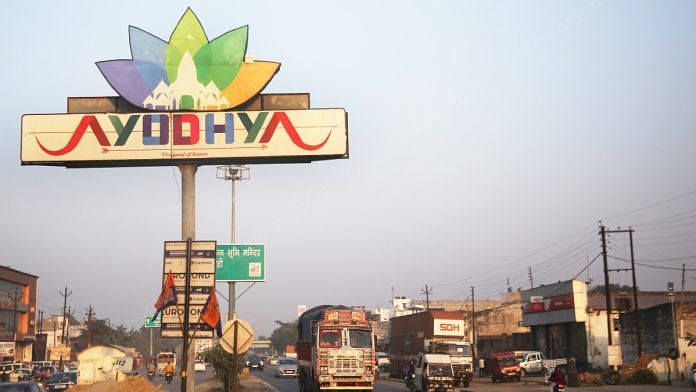The reel begins with two men hanging out on a terrace—and ends with one strangling the other for not knowing what’s happening on 22 January. Social media has been flooded with news reports and content on the consecration of the Ram temple in Ayodhya, a loud buzz that is now clamouring to a cacophonous fever pitch. The moment in India’s history is being memorialised in memes.
This particular reel on Instagram—with a million views, 1,40,000 likes, and 1,20,000 shares—is shaming people for not knowing about the upcoming event while celebrating the scheduled consecration of Ram Mandir. “There’s no reason for you to be alive [if you don’t know],” the reel concludes, with a caption that translates to “if you’re Hindu you should at least know this.” The comments resound with “Jai Shree Ram.”
Another Instagram reel details how people can order free prasad from the Ram temple after 22 January for just Rs 51 — it has 16.9 million views, over 1.1 million likes, and thousands of comments appreciating the initiative.
The consecration of the Ram temple has calcified into something much more concrete in the Indian psyche: it’s become a cultural celebration that goes far beyond the temple itself.
And as always, social media is the litmus test for how deep the impact is.
#RamMandirPranPratistha has been trending on X (Twitter) for weeks. A click through hashtags like #ayodhyarammandir and #22january on Instagram reveals hundreds of thousands of posts, from devotional songs to acts of worship to the slightly more aggressive comedy of the hanging-out-to-strangling reel. There are AI-generated images of gods, colourfully dressed middle-aged women dancing, young children being paraded around in saffron, selfie challenges in Ayodhya, lip-synced songs. It’s all adding to the frenzy around this long-awaited date, seeping into every part of Indian public life—even airline staff are dressing up as Ram and Sita, while those on delayed flights are chanting ‘Jai Shri Ram’.
Also read: Congress boycott right. Ayodhya event not about Ram, but coronates Hindutva as state religion
The influencer effect
Of course, some of the content is being produced by social media influencers invited to the 22 January event.
A few days ago, a group of around 500 influencers set off on a 4,500 km journey to Ayodhya, retracing Ram’s steps after his return from exile. Organised by the Ram Mahotsav Yatra Samiti formed by the All India Influencers Association, the journey will be documented over the next three months. Other influencers have begun travelling to Ayodhya, posting devotional content on their way.
But there has also been a more concerted marketing push.
The Uttar Pradesh government hired social media influencers in December to promote the cultural heritage of Ayodhya and document the construction of the temple—even allocating a budget of Rs 25 lakh.
The official account of the Shri Ram Janmabhoomi Teerth Kshetra, the trust constituted to look after the construction and management of the Ram temple, has nearly five lakh followers on Instagram. One of the latest posts urges social media users to collectively celebrate the return of Ram to his rightful abode with the hashtag #ShriRamHomecoming.
And let’s not forget the red carpet rollout for the older content creators, the original influencers—Bollywood celebrities. Everyone from Rajinikanth to Ranbir Kapoor has been invited, and is expected to attend. Amitabh Bachchan has already bought a plot of land for Rs 14.5 crore in Ayodhya.
All this signals a massive project to make Ayodhya cool. And it might be working, if social media is anything to go by. Content creators have been setting terms and trends online for years now, so roping them in to curate the conversation around the BJP government’s biggest ideological project is only natural.
Also read: Ayodhya is being rebooted, rebuilt, & reimagined— Gen Z pilgrims, luxury hotels, 3D shows
Less humour, more culture
Some of the content veers towards educational and devotional—not necessarily falling into the entertainment or humorous categories. This is due in part to religious respect, but it is also a symptom of the atmosphere around the event. There’s a belligerence in the air, and a feeling of vindictive satisfaction in provocative videos that almost dare viewers to find fault in its content.
Such videos are loud and proud avowal of Hindu culture, the ultimate cultural claim for the Hindu identity. And social media is the obvious soap box.
A recent book by journalist Kunal Purohit, H-Pop: The Secretive World of Hindu Popstars, outlines this exact phenomenon — how Hindutva has seeped into popular culture through music, books, and videos. It’s a cultural project that now subsists entirely by itself, eagerly waiting for moments like the upcoming consecration to rally around.
But this also points to the changing nature of social media content: in this particular socio-religious context, content is meant to declare pride and excitement, not simply entertain the consumer. The worry is that this fever pitch could easily tip over into dangerous territory.
Journalist Ismat Ara recently posted on X addressing Indian Muslims and pointing to all the “online and offline noise” over the Ram temple — “Ignore anything controversial. You don’t owe anyone reactions. Ignore all of it. Don’t get triggered,” she posted. “Don’t fall into any unnecessary debates. Your safety comes first.”
The creative and cultural content is now heading into a countdown towards the consecration. The question is: what will these content creators focus on after 22 January?
Views are personal.
(Edited by Prashant)



